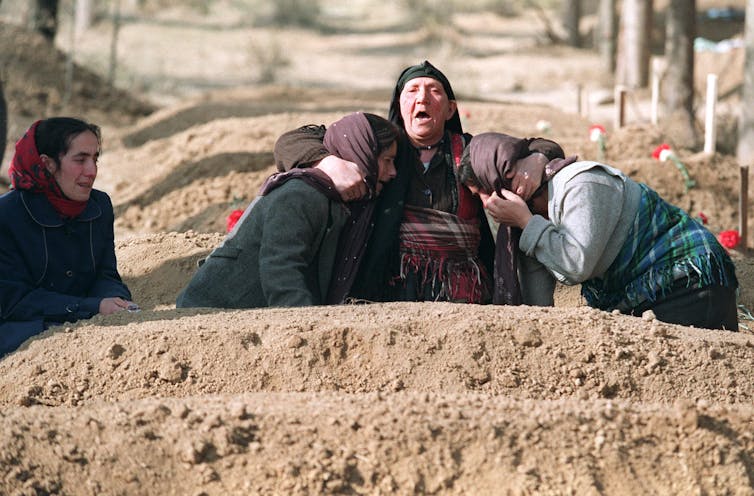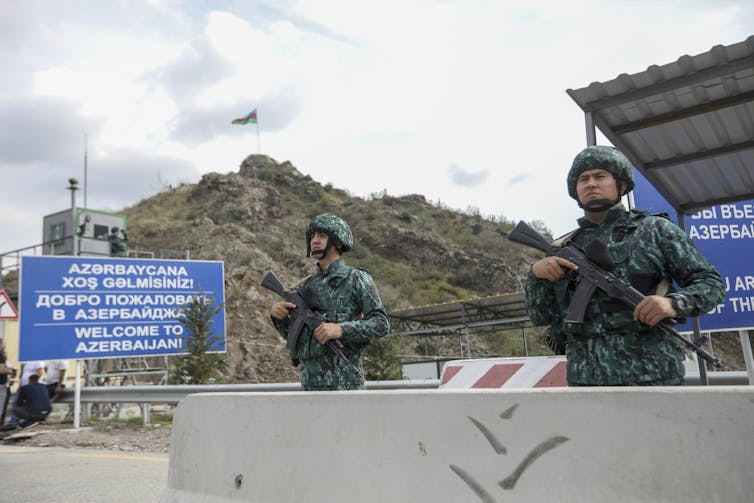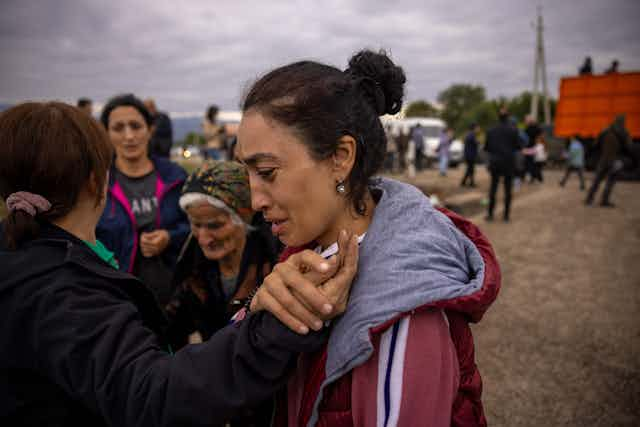Thirty-five years ago, more than 100,000 Armenian protesters took to the streets to convince Soviet leader Mikhail Gorbachev that Nagorno-Karabakh – an ethnically Armenian enclave stuck geographically in the neighboring republic of Soviet Azerbaijan – ought to be joined to Armenia.
In recent days, more than 100,000 people have taken to the streets again. But this time it is Karabakh Armenians fleeing their homes to find refuge in Armenia. They have been decisively defeated by the Azerbaijanis in a short and brutal military operation in the enclave. Their dream of independence appears over; what is left is the fallout.
As a longtime analyst of the history and politics of the South Caucasus, I see the chain of recent events in Nagorno-Karabakh as depressingly predictable. But that is not to say they weren’t avoidable. Rather, greater flexibility from both sides – and less demonization of the other – could have prevented the catastrophic collapse of Artsakh, as Armenians called their autonomous republic, and with it the effective ethnic cleansing of people from lands they had lived in for millennia.
A legacy of Lenin
What began as a struggle to fulfill the promise of Soviet Union founder Vladimir Lenin, that all nations would enjoy the right to self-determination within the USSR, turned into a war between two independent, sovereign states that saw more than 30,000 people killed in six years of fighting.
The 1988 demonstrations were met by violent pogroms by Azerbaijanis against Armenian minorities in Sumgait and Baku. Gorbachev, wary that a shift in territory would foster similar demands throughout the Soviet Union and potentially enrage the USSR’s millions of Muslim citizens, promised economic aid to and protection of the Armenians, but he refused to change the borders.
The dispute became a matter of international law, which guaranteed the territorial integrity of recognized states, in 1991 – with Azerbaijan declaring independence from the Soviet Union and rejecting Nagorno-Karabakh’s autonomy vote. The legal principle of territorial integrity took precedence over the ethical principle of national self-determination.
This meant that under international law, state boundaries could not be changed without the mutual agreement of both sides – a position that favored Azerbaijan. All countries in the world recognized Nagorno-Karabakh as part of Azerbaijan, even, eventually, Armenia.
An unsolved diplomatic problem
But that didn’t mean the status of Nagorno-Karabakh was ever settled. And for all their efforts, outside powers – Russia, France and the United States most importantly – failed to find a lasting diplomatic solution.
The First Karabakh War, which grew out of the pogroms of 1988 and 1990, ended in 1994 with an armistice brokered by Russia and the Armenians victorious.
Moscow was Armenia’s principal protector in a hostile neighborhood with two unfriendly states, Azerbaijan and Turkey, on its borders. In turn, Armenia was usually Russia’s most loyal and dependable – and dependent – ally. Yet, post-Soviet Russia had its own national interests that did not always favor Armenia. At times, to the dismay of the Armenians, Moscow leaned toward Azerbaijian, occasionally selling them weapons.
Only Iran, treated as a pariah by much of the international community, provided some additional support, sporadically, to Armenia.
The United States, though sympathetic to Armenia’s plight and often pressured by its American-Armenian lobby, was far away and concerned with more pressing problems in the Middle East, Europe and the Far East.
What might have been
The disaster that has befallen Nagorno-Karabakh was not inevitable. Alternatives and contingencies always exist in history and, if heeded by statespeople, can result in different outcomes. Analysts including myself, advisers and even the first president of independent Armenia, Levon Ter-Petrosyan, proposed compromise solutions that might have led to an imperfect but violence-free solution to the dispute over Nagorno-Karabakh.
Yet the triumphant Armenian victors of the 1990s had few immediate incentives to compromise. Instead, after the First Karabakh War, they expanded their holdings beyond the borders of Nagorno-Karabakh, driving an estimated one million Azerbaijanis out of their homes and making them hostile to Armenians.

The greatest error of the Armenian leaders, I believe, was to give in to a fatal hubris of thinking they could create a “Greater Armenia” on territory emptied of the people who had lived there. After all, wasn’t this how other settler colonial states, such as the United States, Australia, Turkey, Israel and so many others had been founded? Ethnic cleansing and genocide, along with forced assimilation, have historically been effective tools in the arsenal of nation-makers.
Meanwhile, Azerbaijani nationalism smoldered and intensified around the issue of Nagorno-Karabakh. Many decision-makers in Azerbaijan viewed Armenians as arrogant, expansionist, existential enemies of their country. Each side considered the contested enclave a piece of their ancient homeland, an indivisible good, and compromise proved impossible.
Armenian leaders also failed to fully comprehend the advantages that Azerbaijan held. Azerbaijan is a state three times the size of Armenia with a population larger by more than 7 million people. It also has vast sources of oil and gas that it has used to increase its wealth, build up a 21st-century military and finesse into greater ties with regional allies and European countries thirsty for oil and gas.
Armenia had a diaspora that intermittently aided the republic; but it did not have the material resources or the allies close at hand that its larger neighbor enjoyed. Turks and Azerbaijanis referred to their relationship as “one nation, two states.” Sophisticated weapons flowed to Azerbaijan from Turkey – as they did from an Israel encouraged by a shared hostility with Iran, Armenia’s ally – tipping the scales of the conflict.
Democracy versus autocracy
Armenians carried out a popular democratic revolution in 2018 and brought a former journalist, Nikol Pashinyan, to power. A novice in governance, Pashinyan made serious errors. For example, he boldly, publicly declared that “Artsakh” was part of Armenia, which infuriated Azerbaijan. While Pashinyan tried to assure Russia that his movement was not a “color revolution” – like those in Georgia and Ukraine – Vladimir Putin, no fan of popular democratic manifestations, grew hostile to Pashinyan’s attempts to turn to the West.
While Azerbaijan had grown economically – with the capital city of Baku glittering with new construction – politically, it stagnated under the rule of Ilham Aliyev, son of former Communist Party boss Heydar Aliyev.
The autocratic Ilham Aliyev needed a victory over Armenia and Ngorno-Karabakh to quiet rumbling discontent with the corruption of the family-run state. Without warning, he launched a brutal war against Nagorno-Karabakh in September 2020 – and won it in just 44 days thanks to drones and weapons supplied by his allies.

The goal of the victors then was equally hubristic as that of the Armenians a generation earlier. Azerbaijan’s troops surrounded Nagorno-Karabakh and in December 2022 cut off all access to what was left of the self-declared Republic of Artsakh, starving its people for 10 months. On Sept. 19, 2023, Baku unleashed a brutal blitzkrieg on the rump republic, killing hundreds and forcing a mass exodus.
This ethnic cleansing of Nagorno-Karabakh – first through hunger, then by force of arms – completed the Azerbaijani victory. The defeated government of Artsakh declared it would officially dissolve the republic by the end of 2023.
Learning from defeat and victory
War sobers a people. They are forced to face hard facts.
At the same time, victory can lead to prideful triumphalism that in its own way can distort what lies ahead.
Aliyev appears to have tightened his grip on power, and Azerbaijanis today speak of other goals: a land corridor through southern Armenia to link Azerbaijan proper with its exclave Nakhichevan, separated from the rest of the country by southern Armenia. Voices have also been raised in Baku calling for a “Greater Azerbaijan” that would incorporate what they call “Western Azerbaijan” – that is, the current Republic of Armenia.
Armenians might hope that Azerbaijan – and the international community – take seriously the principle of territorial integrity and protect Armenia from incursions by the Azerbaijani army or any more forceful move across its borders.
They might also hope that the U.S. and NATO, which proclaim that they are protecting democracy against autocracy in Ukraine, will adopt a similar approach to the conflict between democratic Armenia and autocratic Azerbaijan.
But with Russia occupied with its devastating war in Ukraine and stepping back from its support of Armenia, a power vacuum has been formed in the Southern Caucasus that Turkey may be eager to fill, to Azerbaijan’s advantage.
A chance for democratic renewal?
The immediate tasks facing Armenia are enormous, beginning with the housing and feeding of 100,000 refugees.
But this might also be a moment of opportunity. Freed of the burden of defending Nagorno-Karabakh, which they did valiantly for more than three decades, Armenians are no longer as captive to the moves and whims of Russia and Azerbaijan.
They can use this time to consolidate and further develop their democracy, and by their example become what they had been in the years just after the collapse of the Soviet Union: a harbinger of democratic renewal, an example of not just what might have been but of what conceivably will be in the near future.

